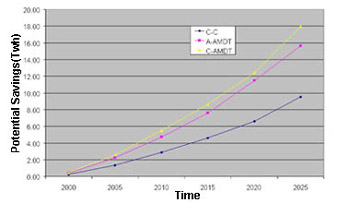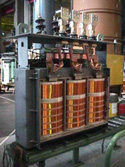Transformers Can Contribute to Global Warming Goals
Copper Applications in Health & Environment
 Power transformers are an essential component in supplying electricity to end-users in industry, commercial offices and homes. Both North America and Europe have several million power transformers installed. They enable voltages to be raised for transmission over long distances from distant power stations, and then progressively reduced to the levels required by consumers.
Power transformers are an essential component in supplying electricity to end-users in industry, commercial offices and homes. Both North America and Europe have several million power transformers installed. They enable voltages to be raised for transmission over long distances from distant power stations, and then progressively reduced to the levels required by consumers.
Power transformers are extremely efficient. Losses are less than 0.25% in large units, and even the smaller transformers used for local distribution have an efficiency of 98% or above. However overall losses are considerable, as there may be as many as five transformation steps between power station and customer. When transformers are very lightly loaded, for example when an office closes for the evening, or school holidays start, losses are increased. The losses due to transformers in a power network can exceed 3% of the total electricity generated, equivalent to about 40% of the total loss from the system.
Until very recently electricity utilities have been prepared to accept the losses from transformers. Energy-saving transformers cost more than less efficient designs and it is often difficult to justify the higher purchasing price. Expensive steels are used in the cores, the copper coils are larger, and designs can be complex to build.
 Potential Savings, Energy-efficient Transformers, Europe
Potential Savings, Energy-efficient Transformers, Europe Source: ETSU
Increased attention is however now being focused on the savings which energy- efficient transformers could make on a national scale and their potential contribution to meeting internationally agreed goals for reducing global warming. In the US distribution transformers have been estimated to account for 140 billion kWh of losses per year, equivalent to the energy demand of a very large city. The Department of Energy is considering whether legislation should be applied to transformer standards. Savings in Europe could be comparable with those achievable by high efficiency electric motors and domestic appliances.
There has so far been only limited pressure in Europe to change transformer standards and purchasing practices. Now however a research project funded by the European Commission under the THERMIE Programme is assessing the scope for installing energy-efficient distribution transformers in utility-operated and private electricity systems. The project is led by the European Copper Institute (ECI), which represents the world's major copper producers and Europe's leading copper fabricators.
ECI are working on the project with a multi-disciplinary team of partners, including Pauwels, a major transformer manufacturer, EDON, a Netherlands electricity utility, KEMA, a Netherlands consulting engineer, and ETSU, a UK energy agency. The main objectives are to measure the contribution which energy-efficient distribution transformers could make to energy savings and climate change in the European Union, and to identify the technical, engineering and financial barriers to their introduction.
The scope for improving the efficiency of distribution transformers can arise in a number of ways. Higher performance raw materials, particularly special steels for building transformer cores, are continually being developed. A fundamentally new type of core material, amorphous iron, produced by cooling molten metal alloy very rapidly, has recently become available. Losses in the core are less than 30% of those of conventional steel cores. The size of the transformers being installed in the network, and the way in which they are loaded, can also increase savings. Transformers are at maximum efficiency when approximately 50% loaded.
There is a challenge to convince customers that, although initial prices are higher, the lifetime owning cost of energy-efficient distribution transformers can be lower. Buyers often prefer to calculate the pay-back period, which may not be the best way to evaluate a capital item such as a transformer, with a very long life span. Some are uncertain about variables such as actual transformer lifetimes or future energy prices.
 1600 kVA Amorphous Iron Transformer
1600 kVA Amorphous Iron Transformer © Pauwels
Reliable data on the actual loading patterns of installed distribution transformers, for example the way in which demand varies in factories, commercial offices and residential neighborhoods, is also scarce. There may be an opportunity for an electricity utility to avoid making a new investment in power generation by installing energy-efficient transformers. Similarly an electricity purchaser may be able to reduce his maximum demand tariff. Demonstration is likely to be a key factor in changing market perceptions. Pauwels, a partner in the THERMIE project, has recently built and installed Europe's largest amorphous iron distribution transformer at a factory in Waterford, Ireland.
Other transformer manufacturers in Europe are starting to introduce energy-efficient models to the standard product range of dry transformers which they sell to private sector buyers.
For more detailed information please call:
Mr H De Keulenaer (Hans)
European Copper Institute
Tervurenlaan 168 B101150
Brussels, Belgium
Tel: +32 2 777.70.84
Fax: +32 2 777.70.79
E-mail: hdk@eurocopper.org
Mr M J McDermott (Mike)
M J McDermott and Associates
76 Park Road
Woking, Surrey GU227DHUK
Tel/fax: +44 1483 761140
E-mail: mjmcdermott@dial.pipex.com
Also in this Issue:
- Transformer Innovations
- Copper Racing to Success
- Transformers Can Contribute to Global Warming Goals
- Copper Patents
